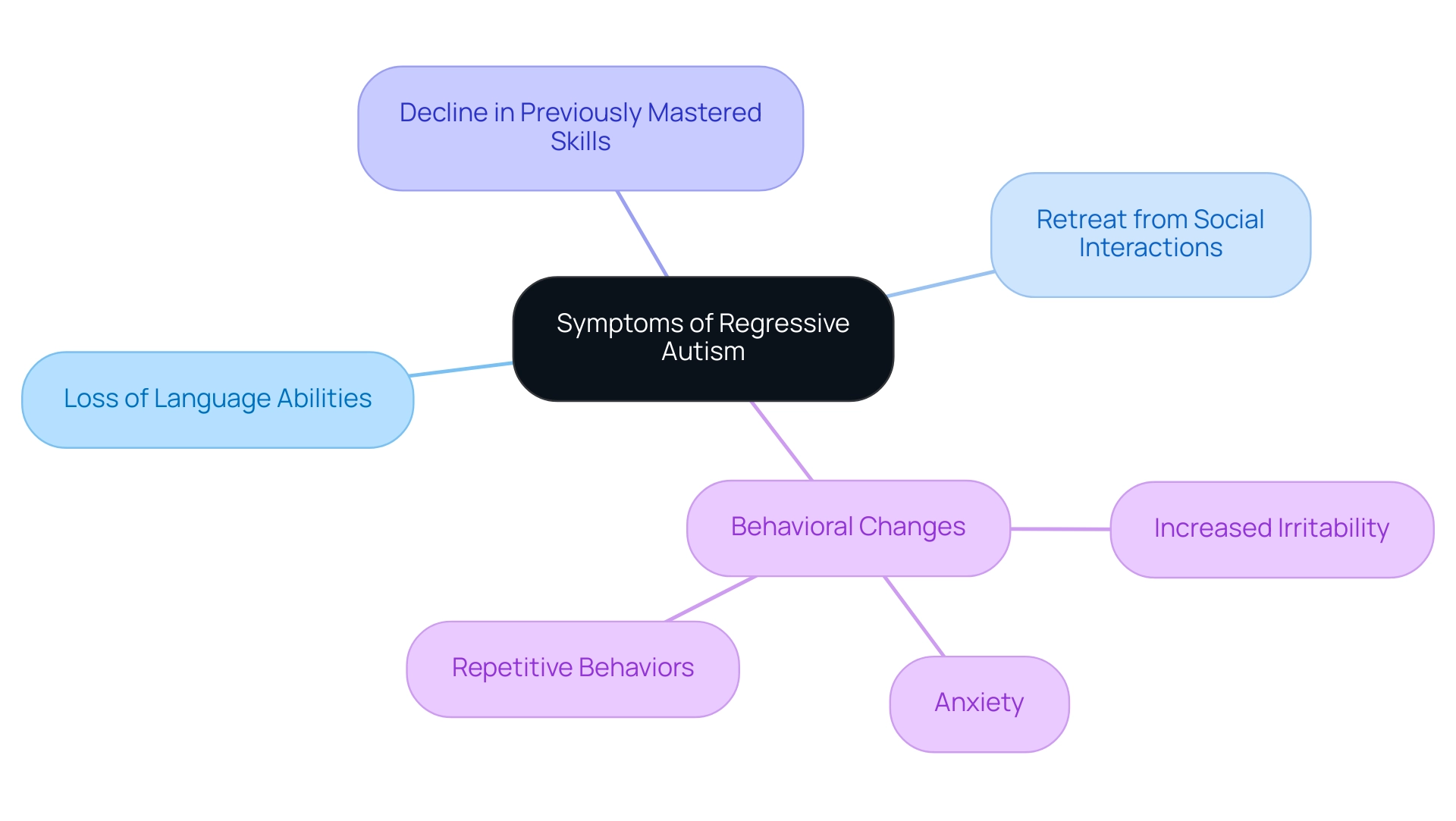Introduction
Navigating the complexities of regressive autism can be a daunting journey for families, marked by unexpected challenges and emotional upheaval. This condition, often characterized by a significant loss of previously acquired skills, typically emerges in early childhood, leaving parents grappling with confusion and concern.
Understanding the key characteristics, symptoms, and underlying causes of regressive autism is crucial for early detection and intervention, enabling families to seek timely support. With a wealth of research highlighting the importance of recognizing these signs, parents are empowered to take proactive steps.
From exploring genetic and environmental influences to examining effective treatment options, this article serves as a comprehensive guide for parent advocates striving to ensure the well-being and development of their children in the face of regressive autism.
Defining Regressive Autism: Key Characteristics and Distinctions
Regressive developmental disorder, commonly known as childhood disintegrative disorder, is characterized by a profound loss of skills that were previously acquired, typically following a phase of normal development. This condition can lead to a worrying decline in communication abilities, social interactions, and essential developmental milestones. Unlike other conditions on the spectrum, what is regressive autism typically appears between the ages of 18 months and 3 years, a period that can be especially perplexing and troubling for guardians and caregivers alike.
Understanding these core characteristics is vital for early recognition and intervention. Recent studies indicate that about 78.8% of school-age autistic youth exhibit progress in at least one developmental area by age 10, highlighting the importance of timely support. Additionally, with 36.5% of caregivers reporting the use of ABA therapy, many parents find it beneficial in helping their children regain lost skills and enhance their overall development.
Recognizing and addressing what is regressive autism is not just about understanding its nature; it's about empowering families to navigate this challenging journey with informed strategies and support. As Judy Singer notes, 'A rainbow infinity sign is another widely used symbol for the condition,' reflecting the evolving perceptions of representation. Moreover, the puzzle piece has been a long-standing symbol of neurodiversity since 1963, yet many activists criticize it for dehumanizing the experience of individuals on the spectrum, prompting a shift towards more inclusive symbols.
These discussions surrounding representation are essential for advocates aiming to comprehend and assist their offspring in a complex environment.

Recognizing the Symptoms: Signs of Regressive Autism
Common symptoms of what is regressive autism can be alarming for parents, often including:
- A significant loss of language abilities
- A retreat from social interactions
- A decline in skills that were previously mastered, such as potty training and engaging in play
Behavioral changes may become evident as well, with young individuals displaying increased irritability, anxiety, and repetitive behaviors. For instance, a young person who once participated in lively conversations or collaborative play may suddenly appear withdrawn and unresponsive.
According to Ozonoff et al., the emergence of these symptoms typically occurs within the first three years of life, with notable onset patterns documented prior to 36 months in autism spectrum disorder (J Autism Dev Disord, 2010). As highlighted by Nouf Backer Al Backer, Assistant Professor of Pediatrics, it is essential to understand that,
the primary goals of this paper are to provide an overview of the various operational definitions of the term 'regression' in the literature.
Recognizing the symptoms of what is regressive autism promptly can greatly influence the effectiveness of subsequent interventions.
The case study titled 'Implications for Early Intervention' emphasizes the need for caregivers and medical staff to actively monitor developmental levels to identify what is regressive autism early, as individuals showing signs of regression may experience more severe symptoms and poorer prognosis. Therefore, parents are encouraged to actively monitor their child's developmental milestones and seek immediate support if they notice concerning changes.

Exploring the Causes: Genetic and Environmental Influences
Emerging research underscores that understanding what is regressive autism often involves recognizing its emergence from a complex interplay of genetic and environmental factors. Significantly, particular genetic markers have been identified that correlate with spectrum disorders, indicating a substantial genetic predisposition. For instance, a pivotal study titled 'Next Generation Sequencing of 134 Children with Autism Spectrum Disorder and Regression' sought to explore what is regressive autism through the genetic sequencing of 134 children diagnosed with ASD who experienced regression in their developmental milestones.
This study, backed by the National Institute for Health Research Applied Research Collaboration East of England, offers essential insights into the genetic factors that may underlie developmental disorders, potentially guiding future interventions. Grigorenko, E.L. noted, 'Next Generation Sequencing of 134 Children with Autism Spectrum Disorder and Regression,' which highlights the importance of this research in understanding genetic influences. Furthermore, only variants with a ≥ 0.8 were retained after imputation, underscoring the methodological rigor of the genetic analysis.
Additionally, environmental factors—such as exposure to toxins or infections during pregnancy—have been associated with the onset of developmental disorders. Recent statistics reveal that 188,630 individuals had Townsend deprivation index scores available, providing a broader context for understanding environmental influences. By understanding these multifaceted elements, guardians can better identify potential risks and effectively advocate for their children's health and well-being.
The Importance of Early Detection and Diagnosis
The early detection and diagnosis of what is regressive autism are crucial for facilitating effective intervention strategies. Research underscores that timely evaluations from qualified professionals can make a significant difference; parents should not hesitate to seek assessments as soon as they observe concerning behaviors. For instance, the analysis of youth across 11 sites in the United States revealed a noteworthy prevalence of 21.5% for Autism Spectrum Disorder (ASD), with:
- 80.2% having an ASD diagnostic statement
- 38.1% being eligible for special education
- 79.4% having an ASD ICD code
This highlights the prevalence and necessity of early recognition. Additionally, among Hispanic youth, 748 had intellectual disability information, emphasizing the need for early detection across diverse populations. Interventions such as Applied Behavior Analysis (ABA) therapy have proven to enhance a young person's development significantly, particularly in communication, social skills, and behavioral challenges.
As McArthur D. emphasized in the 2020 monitoring report, early identification is vital—those who receive support sooner have markedly better outcomes in their developmental trajectories. Furthermore, longitudinal assessments of ADOS scores can provide insights into changes in symptom severity, reinforcing the importance of ongoing evaluations. The evidence is clear: the sooner an individual begins to receive intervention services, the greater their chances for achieving positive developmental milestones.
Interventions and Support: Treatment Options for Regressive Autism
The landscape of interventions for what is regressive autism is diverse and multifaceted, primarily encompassing:
- Behavioral therapies
- Speech and language therapy
- Occupational therapy
Among these, Applied Behavior Analysis (ABA) therapy stands out for its proven efficacy in tackling behavioral challenges while facilitating skill acquisition. Notably, research indicates that the mean total AIM score for youth undergoing these therapies was 220.8, reflecting the frequency and impact of symptoms addressed through structured interventions.
In the words of Thurm et al., regression in ASD may best be represented as a dimensional phenomenon that starts with a continuum of varying degrees of early delays in the attainment of socio-communicative skills and may be followed by a continuum of varying degrees of loss. This expert insight underscores the complexity of regression and the importance of tailored interventions. Furthermore, a case study highlighted the strengths of non-drug therapy for youths with ASD, despite acknowledging potential limitations such as selection bias and reliance on caregiver-reported data.
The support of parent-led groups and resources can be invaluable, providing both guidance and a sense of community. This collective support empowers families to effectively navigate the complexities of what is regressive autism. By exploring and utilizing these treatment options, parents can cultivate an environment that fosters growth and development tailored to their child's unique needs.
Success stories abound, showcasing how families have witnessed remarkable progress through consistent engagement with effective therapies.
Conclusion
Understanding regressive autism is crucial for families facing its challenges, as it involves a significant loss of previously acquired skills. Early recognition of symptoms, such as changes in communication and social interaction, is essential for timely intervention.
Research indicates that regressive autism often results from a combination of genetic and environmental factors, equipping parents with knowledge to advocate effectively for their children. Early diagnosis is vital; parents should seek assessments as soon as they notice concerning behaviors to ensure their children receive the necessary support.
Various interventions are available, including:
- Applied Behavior Analysis (ABA) therapy
- Speech therapy
- Occupational therapies
These interventions have proven effective in helping children regain skills and enhance overall development. Support from parent-led groups also provides invaluable resources and a sense of community, empowering families on this journey.
Navigating regressive autism can be challenging, but it is filled with hope. By staying informed, recognizing early signs, and pursuing appropriate interventions, parents can significantly improve their children’s developmental outcomes. Proactive steps taken now can lead to brighter futures, affirming that with the right support, every child has the potential to thrive.
Frequently Asked Questions
What is regressive developmental disorder?
Regressive developmental disorder, also known as childhood disintegrative disorder, is characterized by a significant loss of previously acquired skills after a phase of normal development, impacting communication, social interactions, and essential developmental milestones.
At what age does regressive autism typically appear?
Regressive autism usually appears between the ages of 18 months and 3 years.
Why is early recognition and intervention important for regressive autism?
Early recognition and intervention are crucial because studies show that about 78.8% of school-age autistic youth make progress in at least one developmental area by age 10, highlighting the need for timely support.
What percentage of caregivers report using ABA therapy for their children with regressive autism?
Approximately 36.5% of caregivers report using ABA therapy to help their children regain lost skills and improve overall development.
What are common symptoms of regressive autism?
Common symptoms include significant loss of language abilities, withdrawal from social interactions, and decline in previously mastered skills, such as potty training and engaging in play.
What behavioral changes might be observed in children with regressive autism?
Children may show increased irritability, anxiety, and repetitive behaviors, and may become withdrawn and unresponsive compared to their previous behavior.
How can recognizing symptoms of regressive autism impact interventions?
Prompt recognition of symptoms can greatly influence the effectiveness of interventions, as individuals showing signs of regression may face more severe symptoms and poorer prognosis.
What should parents do if they notice concerning changes in their child's development?
Parents are encouraged to actively monitor their child's developmental milestones and seek immediate support if they observe any concerning changes.




